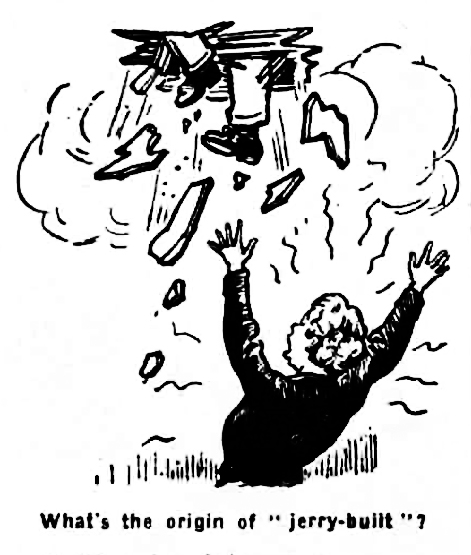
Whilst I was researching the area of Toxteth Park known as ‘Willaloo‘ in the mid-1800s, I kept coming across the term “Jerry Built” and “Jerry Builder” in the British Newspaper Archives. It was used to describe the poor quality of some buildings in Liverpool.
I knew what the term meant – shoddily built – but I wondered what the phrase’s origin was, especially as it appears a lot earlier than I had expected. I didn’t have a clue and I soon found out I wasn’t alone.
Here is what the Oxford English Dictionary says:
Badly or hastily built with materials of poor quality.
Origin
Mid 19th century: origin unknown; sometimes said to be from the name of a firm of builders in Liverpool, or to allude to the walls of Jericho, which fell down at the sound of Joshua’s trumpets (Josh. 6:20).
The Wikipedia entry states:
Etymology: Unknown, which has engendered many theories.”
They’re not kidding, two of the most unlikely examples being in the OED. The reference to the Walls of Jericho seems as likely as the two finger salute originating from the Battle of Agincourt.
These next explanations seem to have little or no foundation (pretty much like a Jerry Built house then):
Jerry-built. The cheap, flimsy constructs of a Mr. Jerry of the Jerry Bros. of Liverpool may have inspired the word jerry-built. Jerry-built could also be connected with the trembling crumbling walls of Jericho; the prophet Jeremiah, because he foretold decay; the word jelly, symbolizing the instability of such structures; or the Gypsy word gerry, for “excrement.” Still another theory suggests a corruption of jerry-mast, a name sailors and ship builders gave to makeshift wooden masts midway through the last [19th] century. Jerry-masts or rigs derive their name from the the French jour, “day,” indicating their temporary nature.
The cartoon at the top of this post is from a 1939 newspaper quiz that asks the Question “What is the origin of Jerry-Built? Unfortunately, their answer was the same as the OED.
It has also been suggested that it is from the WW1 nickname for Germans. Another explanation refers to a 19th century derogatory name for a public house; ‘Jerry Shop’ or sometimes ‘Tom and Jerry Shop’ but I am quite sure that is not the case, but more about that later.
So determined to find out, and after a bit of digging, I think I have found it, and it has its origins in Liverpool.
The earliest appearance of ‘Jerry-Built”?
Jerry-built referred to poor houses or buildings made of the cheapest, most inferior materials, these were speculative builders who often had very little or no experience. It was common that the structures had no foundations and their sewer pipes led nowhere. Lacking in proper ventilation and full of damp, these properties have been referred to as ‘Fever Sheds’.
The earliest appearance of “Jerry Built” I could find is in the Liverpool Mercury 1832, it sarcastically refers to a meeting discussing housing as being attended by:
“…members of the Blue Bell Club, the Jerry-Building Society, etc.”

After this first appearance of the term in print, the expression gains popularity, at first almost exclusively in Liverpool, a little later its use has spread across the country.
By the 1860s the term “Welsh Jerry Builders” is often used. The Welsh house builders of Liverpool are held in high regard for the thousands of good quality terraced houses they built from the 1870s. These references are to an earlier generation who erected their slums before the 1875 Act was passed that ensured the quality of house building:
The 1875 Act imposed a duty on local authorities to regulate housing by the use of byelaws, and subsequently all byelaw terraced housing was required to have its own privy (outhouse), with rear access for the collection of the night soil (Human waste). The houses had to meet minimum standards of build quality, ventilation, sanitation and population density.
Wikipedia
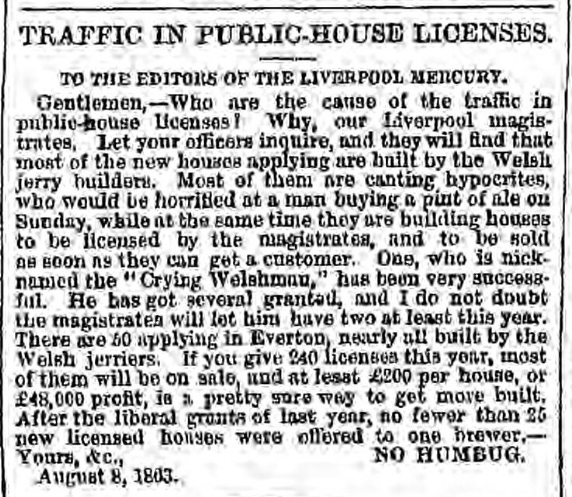
Origin
A newspaper article from the Birmingham Daily Post in 1883 gives us a great insight into just how bad these houses were, it also gave me a great hint to where the name from, step forward – Jerry Diddler.
The House that Jerry Built.
The Diddler family is of considerable antiquity. Whether its founder, the original ‘Jeremy’ came over with the Conqueror may be doubtful, but it is probable, great number of his descendants to be found at the present time in every part of England

In the article below an man named Walter Pierce takes objection as being referred to as a “rough and course Jerry Builder”:
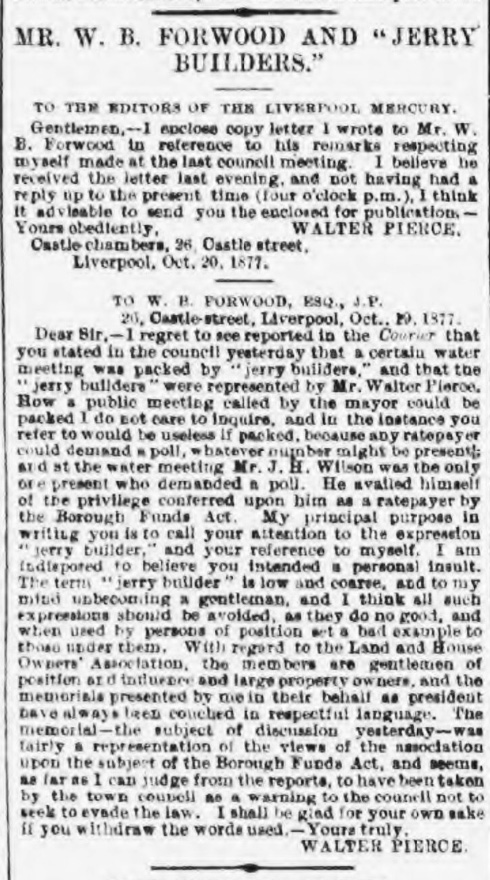
Find My Past British Newspapers
Jerry Diddler
In 1803 the dramatist James Kenney (1780 – 25 July 1849) published his first play ‘Raising the Wind’ featuring an artful swindler called Jerry Diddler. Raising the wind was a slang term for obtaining a loan.
Waiter. Oh, it’s Mr. Diddler trying
to joke himself into credit at the bar. But it
won’t do, they know him too well.Sam: Never you fear that, mun. I wasn’t born
two hundred miles north of London, to be done by
Mr. Diddler, I know.
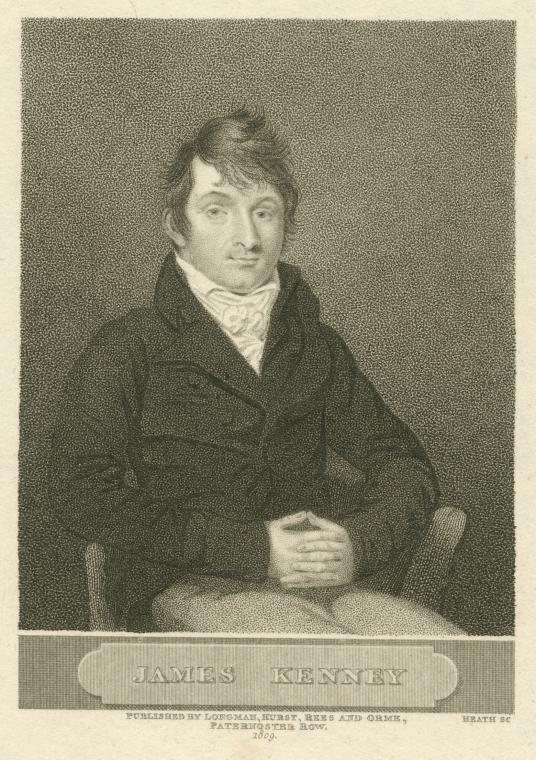
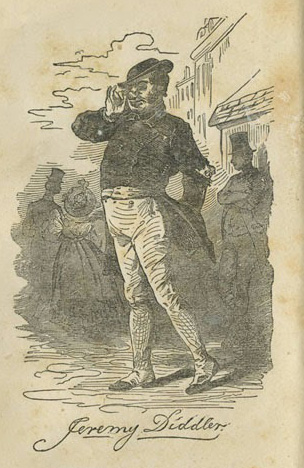
So, with Jerry Diddler (rhymes with fiddler), James Kenney in one character popularized two well known phrases, ‘Jerry’ (disreputable) and ‘Diddler’ (meaning swindler – “diddle someone out of their inheritance”.
In 1868, an American book was published called “The Diddler” by A. E. Senter, warning its readers of swindlers, James Kenney is credited:
THE LADIES AND GENTLEMEN, MERCHANTS, BUSINESS MEN, MECHANICS AND LABORERS, HUSBANDS AND WIVES, CITIZENS OF THE UNITED STATES AND PEOPLE OF THE WORLD, GREETING:
To be posted and warned of the wiles of the Diddlers of our race, may save one from becoming their dupe, and, perhaps, from ruin. ‘Where no counsel is, the people fall: but in the multitude of counsellors there is safety.’
“A word to the wise is sufficient;” and to all others these pages are submitted.
We would invite the attention of the reader to “Kenney’s Farce Of Raising The “wind,” at the end of this volume. He will then be, if he is not already, familiar with Mr. Diddler, and perhaps better appreciate the main feature of this work.
Earlier untrustworthy Jerrys
The name Jerry had been linked to untrustworthy characters prior to Jerry Diddler, Jerry Sneak appeared in the play ‘The Mayor of Garratt‘ by Samuel Foote in 1764.
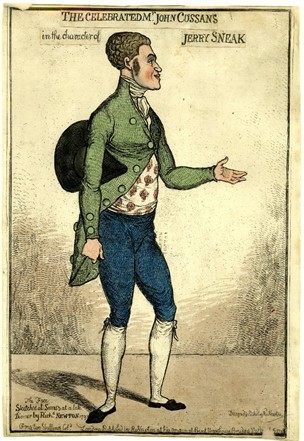
The Celebrated Mr John Cussans in the Character of Jerry Sneak. The British Museum
In The Metropolitan Magazine in 1838 a story was published called The Mariner’s Daughter which shows how the name Jerry Sneak was becoming a popular nickname:
The name of this junior lieutenant was Mr. James Snook. They soon found out he was a regular tale-bearer ; and as such, doubtless, had at first and was still to make himself acceptable to his patron. he crew, on this, lost no time in rechristening him, which they did by the style and title of Jerry Sneak, and by no other name did he ever afterwards go.
Tom and Jerry
No, not the cartoon of the fighting cat and mouse, Tom and Jerry first appeared in 1821 in a publication called ‘Life in London’ by Pierce Egan, it follows the story of two characters called Corinthian Tom and Jerry Hawthorn, who together with their friend Bob Logic embark on “rambles and sprees through the metropolis”.
In the 1800s the men’s antics would inspire the phrase ‘Jerry Shop’ which was a ‘Low-down drinking shop’. Read more here http://skittishlibrary.co.uk
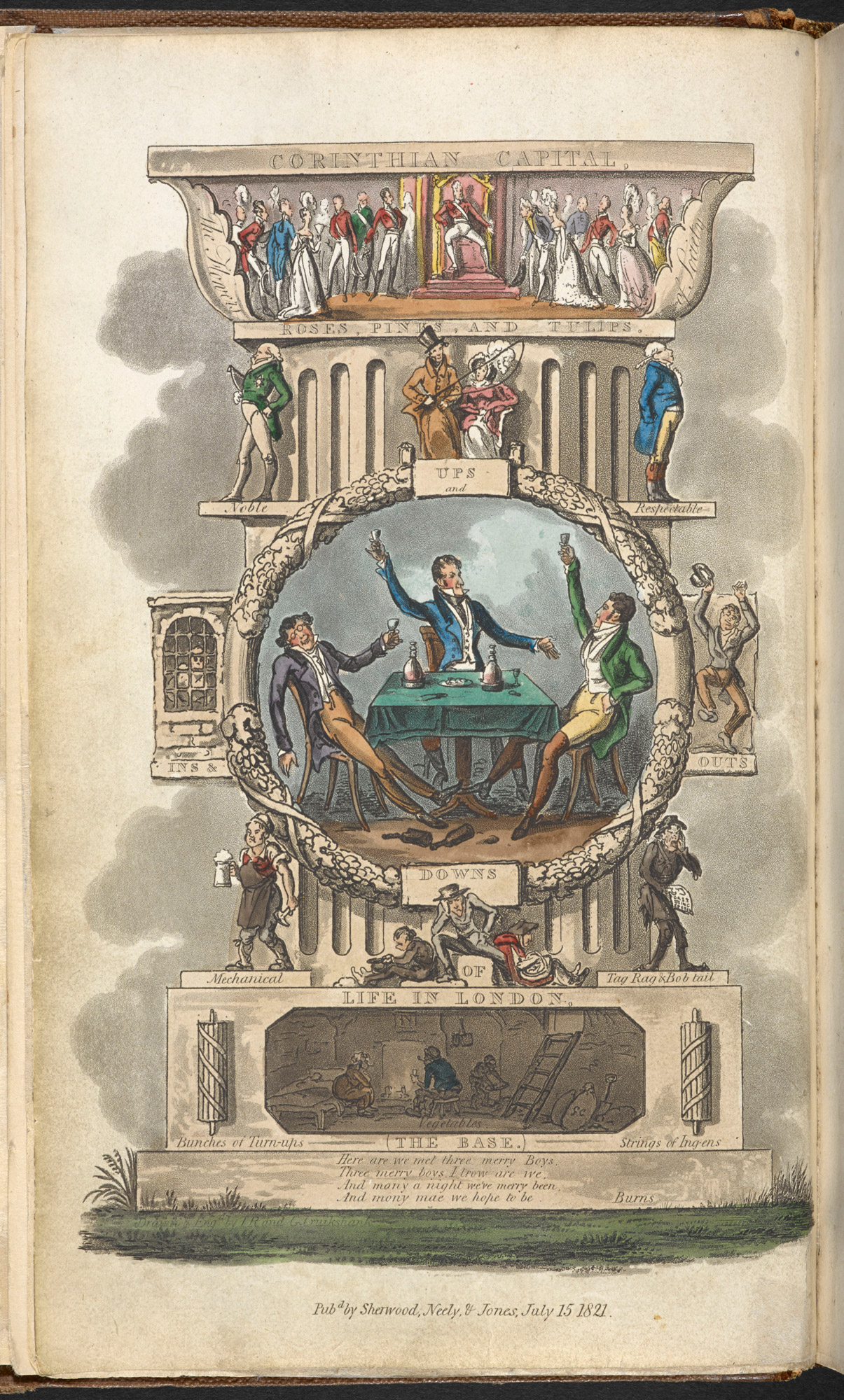
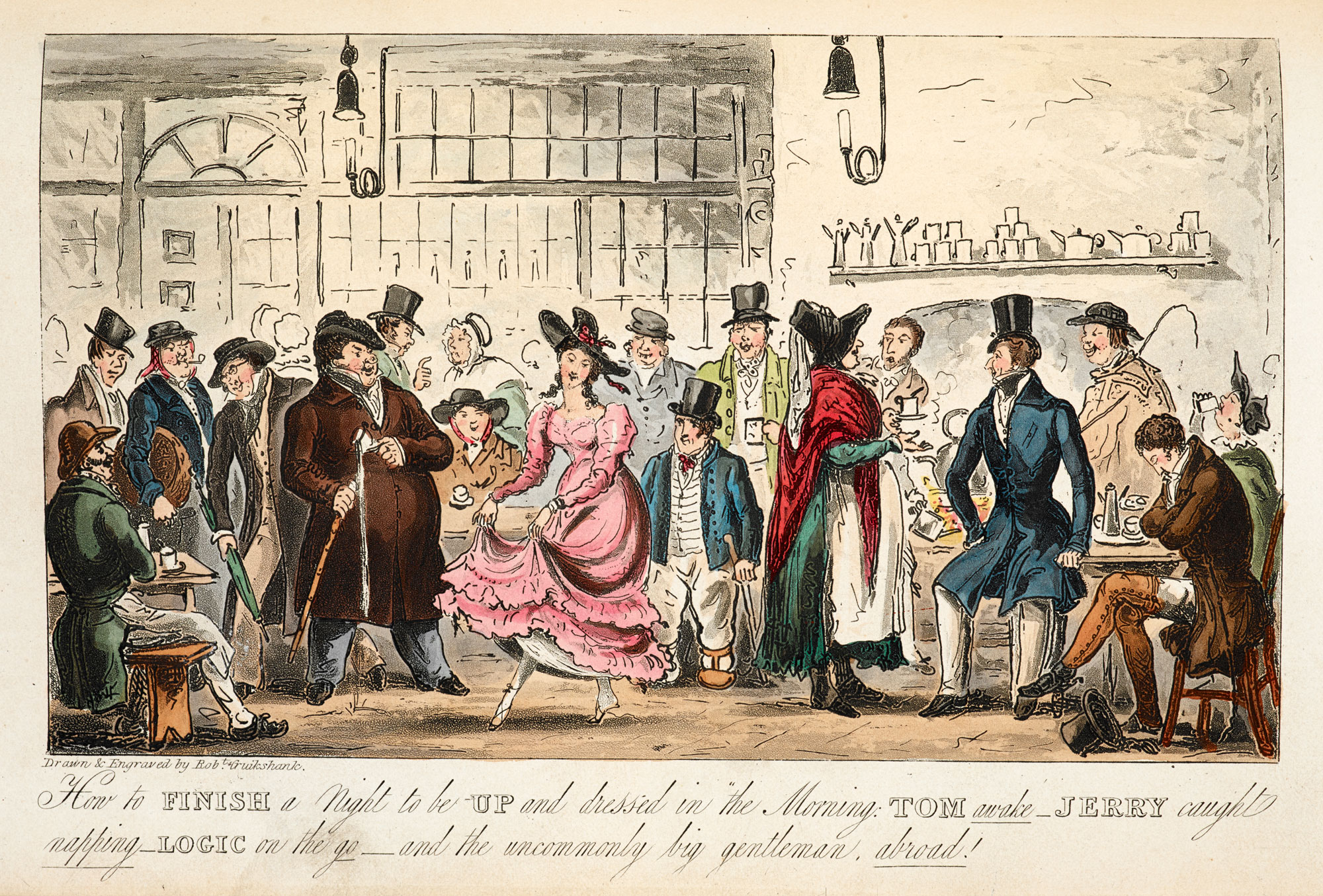 Above images from “Tom and Jerry’s Life in London Tom and Jerry’s Life in London”:
Above images from “Tom and Jerry’s Life in London Tom and Jerry’s Life in London”:
Tom and Jerry
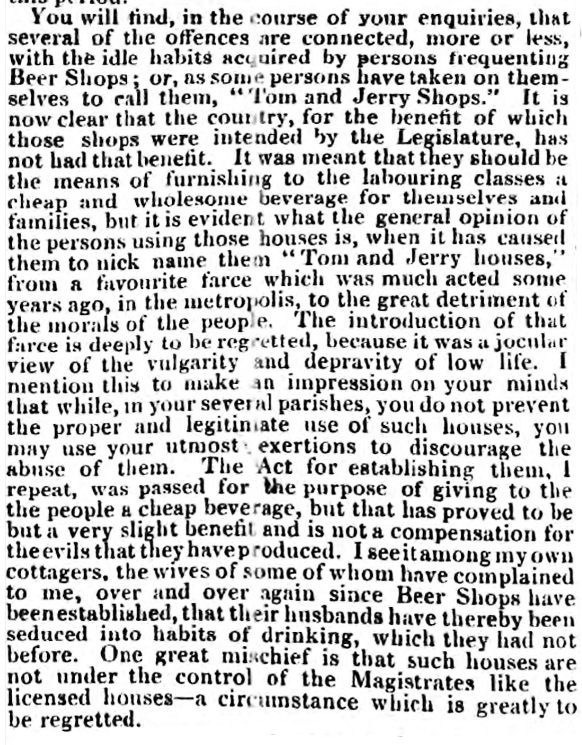

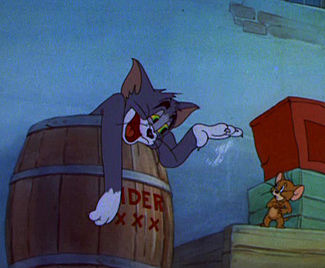
Summary
It seems that Jerry Diddler is the most likely source of the term ‘Jerry Built’ as his character, being a swindler, is the closest match, but it seems he was descended from a long line of ne’er-do-wells that went by the same Christian name.
‘Cowboy Builders’ took over from Jerry Builders, it is unclear if these were a new construction company or the same with a re-brand. Maybe Jerry declared himself bankrupt and registered the new company on the same day?
I contacted the Oxford English Dictionary with my findings and hopefully one day I’ll see my description in print. Now I just need to find the origin of the nickname my dad used to for me – ‘Buggerlugs’.
If you enjoyed this post and would like to show your appreciation, you can Buy me a coffee. This will give me £5 to help me fund my research and continue this website. If you can afford it, you can buy me as many as you like. I’ve got plenty more posts to come. Some of these contain some very important discoveries.
Just click on the logo below.
Copyright notice:
Copyright of original archive images belongs to those named below the images. All original research, photographs taken by ourselves, illustrations, artists impressions, and archive images and maps that have notes added are all ©Jim Kenny. Permission to share is only granted if the site is credited and a link provided.

As I was reading this I thought – you must tell the OED your findings. So glad to see that you did!
Look forward to hearing the origin of ‘buggerlugs’, a word I heard often in my youth too.
A very entertaining and informative piece.
So, “buggerlugs”, (obviously our parents came from the same area) – lugs being ears, I remember “lugsy” as an epithet for persons endowed with generous auditory organs.
Perhaps it’s just a semi-profane rhythmic insult, with the bugger part coupling nicely with lugs? q.v. f**knut
Hi Michael, I think you’re right. The more I think of it, the phrase was used if you made a comment on a private conversation (earwigging), this would provoke the comment “never you mind buggerlugs!”.